Determination of the Potential Thermal Gradient for the Mexican Pacific Ocean
Abstract
:1. Introduction
2. Materials and Methods
2.1. Study Area
Temperature
2.2. Graphic Representation of the Thermal Gradient, According to Their Vertical Profiles (0–1000 m Depth)
2.3. Analysis and Interpretation of Data by Geographic Information Systems (GIS)
3. Results
3.1. Vertical Profiles of Historical Temperature Differences
3.1.1. Gulf of Tehuantepec
3.1.2. The Eastern Pacific Warm Pool of the Mexican Pacific
3.1.3. The Gulf of California and Mexican Northwest Pacific
3.2. Historical Seasonal Thermal Difference (TG) Maps (0 to 1000 m Depth)
3.2.1. Spring
3.2.2. Summer
3.2.3. Autumn
3.2.4. Winter
3.3. Energy Demand Sites
4. Discussion
4.1. Areas That Are Deemed Unsuitable
4.2. Zones That Seem Promising
4.3. Islands
5. Conclusions
Acknowledgments
Author Contributions
Conflicts of Interest
References
- Avery, W.H.; Wu, C. Renewable Energy from the Ocean: A Guide to OTEC; Oxford University Press: Oxford, UK; Research Triangle Institute: Durham, NC, USA, 1994. [Google Scholar]
- Vega, L.A. OTEC Environmental Impact: Historical Perspective; HINMREC-HNEI-UH & Lockheed Martin Maritime Systems & Sensors; University of Hawaii: Honolulu, HI, USA, 2009; p. 57. [Google Scholar]
- García Huante, A. Posibles Efectos Oceanográficos por la Operación de una Planta OTEC en Puerto Ángel, Oaxaca, México. Master’s Thesis, Posgrado en Ciencias del Mary Limnología, Universidad Nacional Autónoma de Mexico, Mexico City, Mexico, 2015. [Google Scholar]
- Beck, E.J. Ocean Thermal Gradient Hydraulic Power Plant. Science 1975, 189, 293–294. [Google Scholar] [CrossRef] [PubMed]
- Kim, H.-J. Current Status of OTEC around the World; A Brief Survey Report for IEA-OES; Korea Research Institute of Ships and Ocean Engineering (KRISO): Daejeon, Korea, 2017. [Google Scholar]
- Makai’s Ocean Thermal Energy Conversion (OTEC) Power Plant, Hawaii. Power Technology. 2017. Available online: http://www.power-technology.com/projects/makais-ocean-thermal-energy-conversion-otec-power-plant-hawaii/ (accessed on 17 May 2017).
- Matthieu, M.; Sinama, F.; Lucas, F. Equivalent Gibbs systems for modelling an onshore OTEC experimental plant on Reunion Island. Int. J. Energy Res. 2013, 37, 1112–1121. [Google Scholar]
- Crews, R. OTEC Sites, Aquarius Rising Maldives—An Ocean Research Centre and Eco-Tourist Facility. 1997.
- Aviña, H. Factibilidad de Instalar una Planta OTEC (Ocean Thermal Energy Conversion) en las Costas de México. Bachelor’s Thesis, Universidad Nacional Autónoma de Mexico, Mexico City, Mexico, 2007. [Google Scholar]
- Vázquez de la Cerda, R. Boletín Informativo ESIA IPN Mayo-Junio; IPN-ESIA: Mexico City, Mexico, 1984. [Google Scholar]
- Francisco, B.G.J. Evaluación del Potencial de Conversión de Energía Renovable en el Caribe Mexicano. Master’s Thesis, Posgrado en Ciencias del Mar y Limnología, Universidad Nacional Autónoma de Mexico, Mexico City, Mexico, 2011. [Google Scholar]
- De la Lanza-Espino, G. Gran Escenario de la Zona Costera y Oceánica de México. Ciencias 2004, 76, 4–13. [Google Scholar]
- Yolanda, H.C. Contaminación Biológica en la Bahía de Puerto Ángel, Oaxaca. 1997. Available online: http://www.umar.mx/revistas/2/contaminacion.pdf (accessed on 5 July 2017).
- Alatorre Mendieta, M.Á.; Hernández Contreras, R.E.; García Huante, A.; y Rodríguez Cueto, Y. Atlas de Potencial Energético del Océano en México por Gradiente Térmico; Línea Estratégica de Energía por Gradiente Térmico del Centro Mexicano en Innovación de Energías del Océano; CEMIE-Océano: Mexico City, Mexico, 2017. [Google Scholar]
- Kessler, W.S. The circulation of the eastern tropical Pacific: A review. Prog. Oceanogr. 2006, 69, 181–217. [Google Scholar] [CrossRef]
- De la Lanza, G.E. Oceanografía de Mares Mexicanos; de la Lanza, G., Ed.; AGT Editor: Mexico City, Mexico, 1991; 569p. [Google Scholar]
- Stumpf, H.G.; Legeckis, R.V. Satellite observations of mesoscale eddy dynamics in the eastern tropical Pacific Ocean. J. Phys. Oceanogr. 1977, 7, 648–658. [Google Scholar] [CrossRef]
- Stumpf, H.G. Satellite detection of upwelling in the Gulf of Tehuantepec, Mexico. J. Phys. Oceanogr. 1975, 5, 383–388. [Google Scholar] [CrossRef]
- Roden, G.I. Sobre la circulación producida por el viento en el Golfo de Tehuantepec y sus efectos sobre las temperaturas superficiales. Geophys. J. Int. 1961, 1, 55–76. [Google Scholar]
- Meave del Castillo, M.E. Diatomeas (Bacillariophyta), Dinoflagelados (Dinophyta) y Silicoflagelados (Dictyochophyceae) Marinos del Pacífico Mexicano, con Énfasis en la Porción Tropical; Informe Final; Proyecto BA008; Sistema Nacional de Información sobre Biodiversidad de México-Comisión Nacional para el Conocimiento y Uso de la Biodiversidad (CONABIO): Mexico City, Mexico, 2006; 80p. [Google Scholar]
- Lavín, M.F.; Robles, J.M.; Argote, M.L.; Barton, E.D.; Smith, R.; Brown, J.; Kosro, M.; Trasviña, A.; Vélez y, H.S.; García, J. Física del Golfo de Tehuantepec. Cienc. Desarro. 1991, 18, 97–108. [Google Scholar]
- Fiedler, P.C.; Talley, L.D. Hydrography of the eastern tropical Pacific: A review. Prog. Oceanogr. 2006, 69, 143–180. [Google Scholar] [CrossRef]
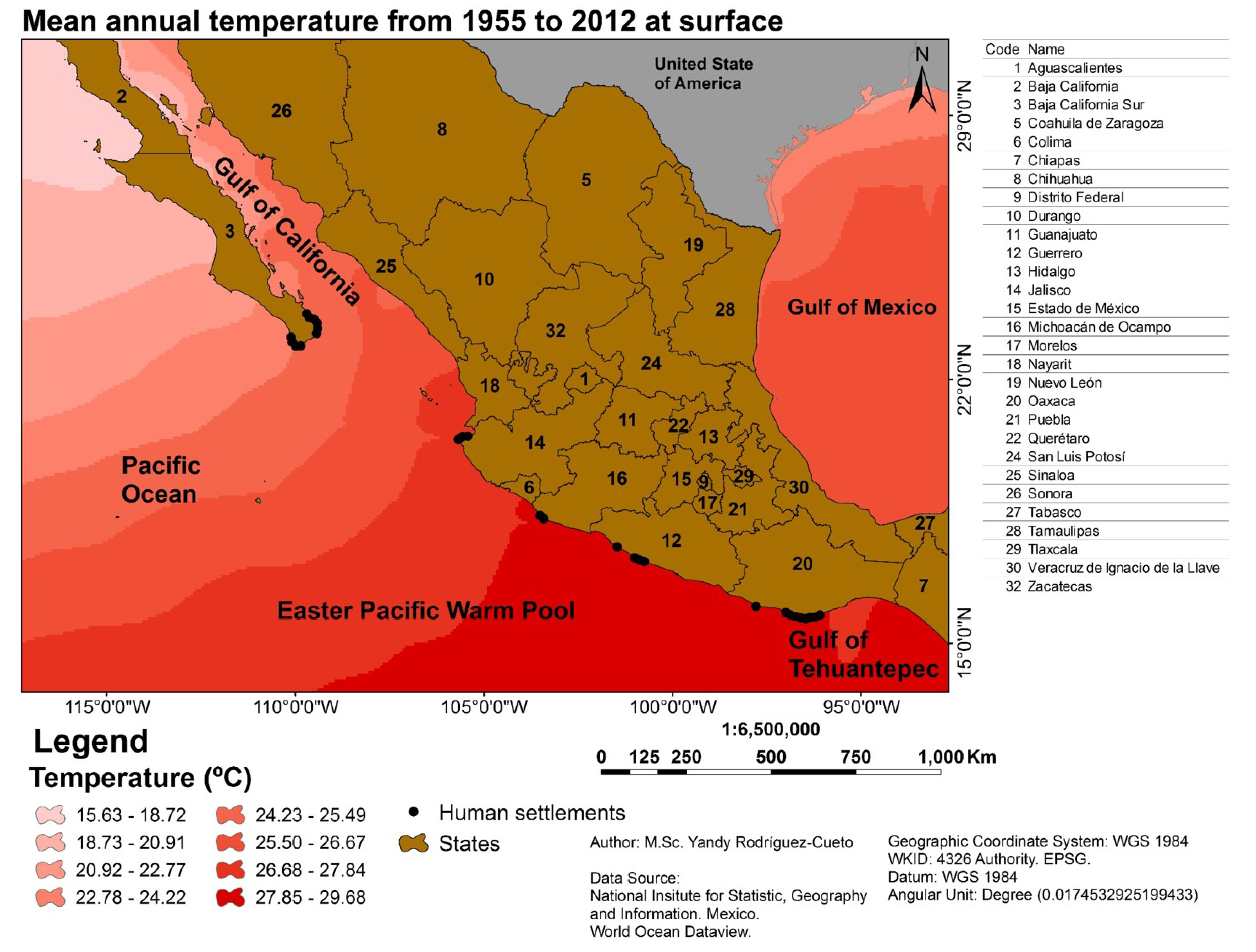
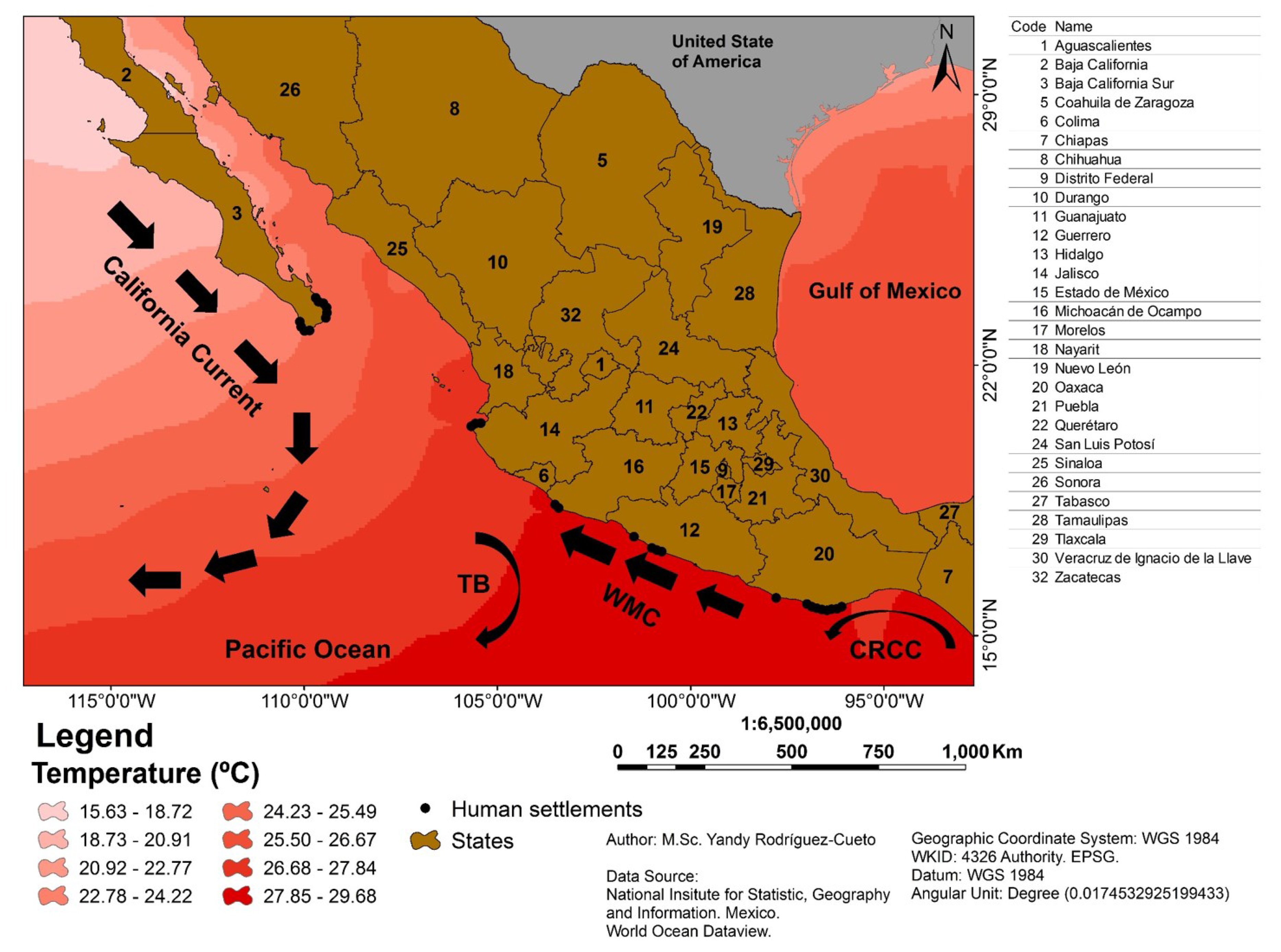
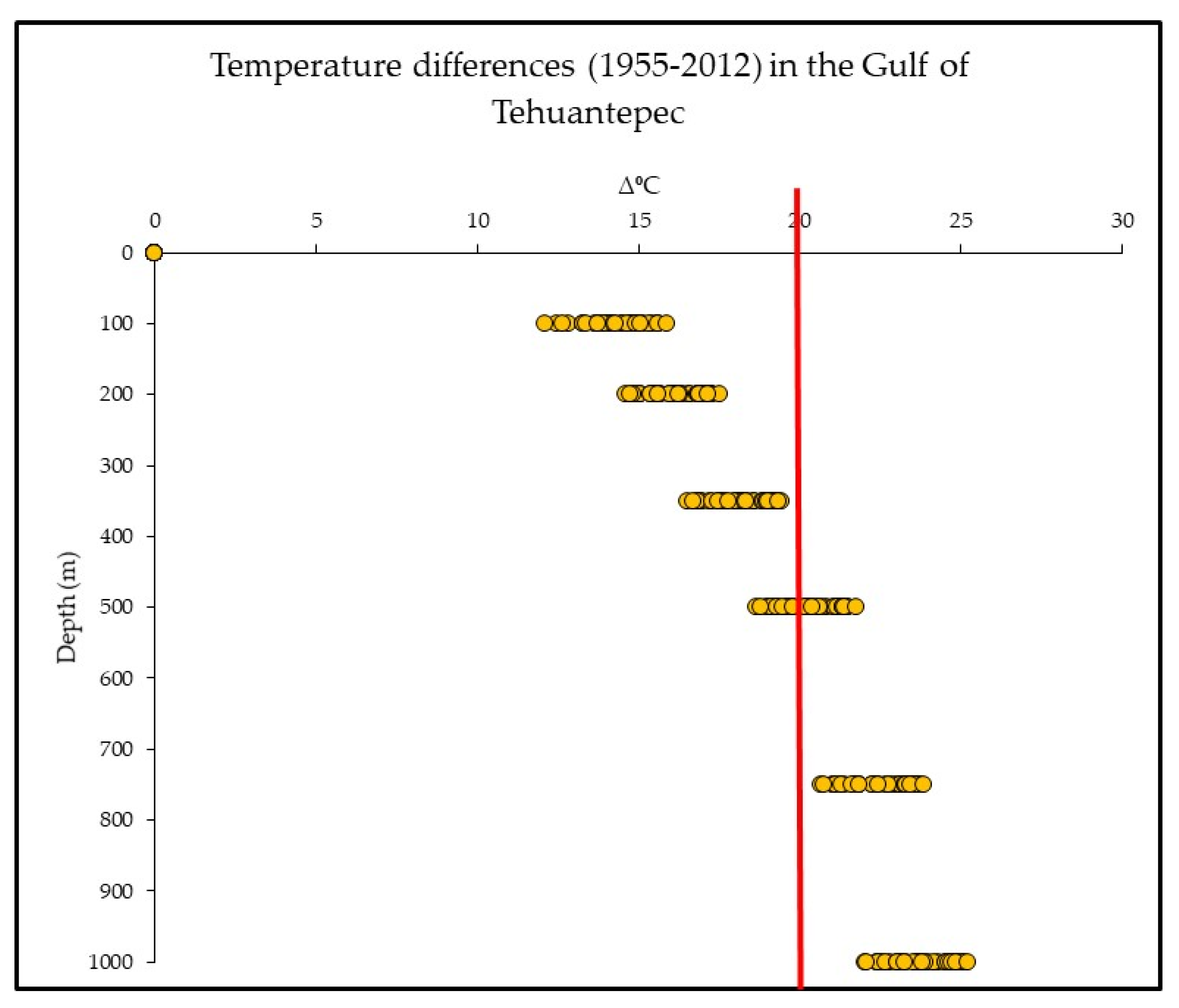
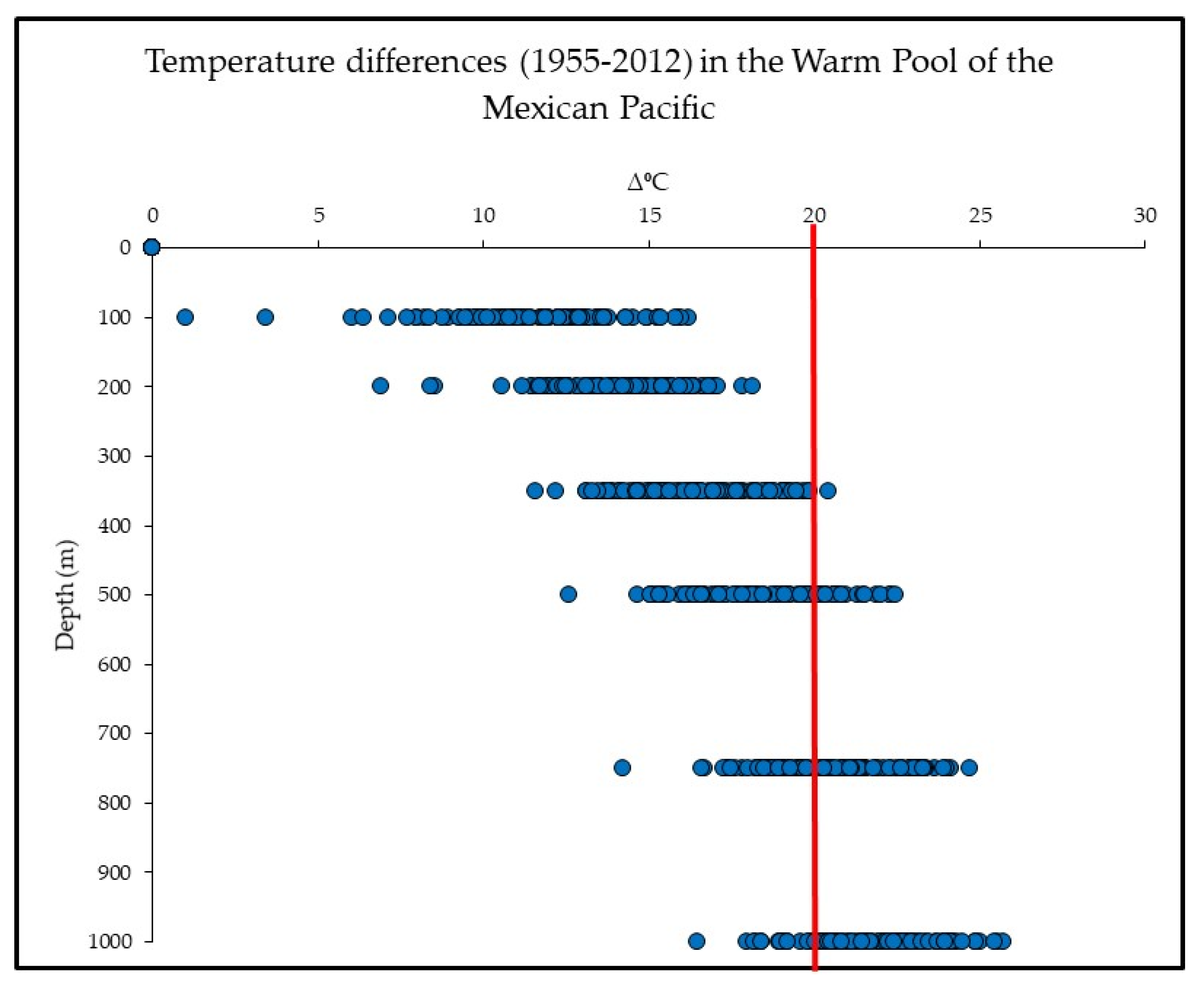
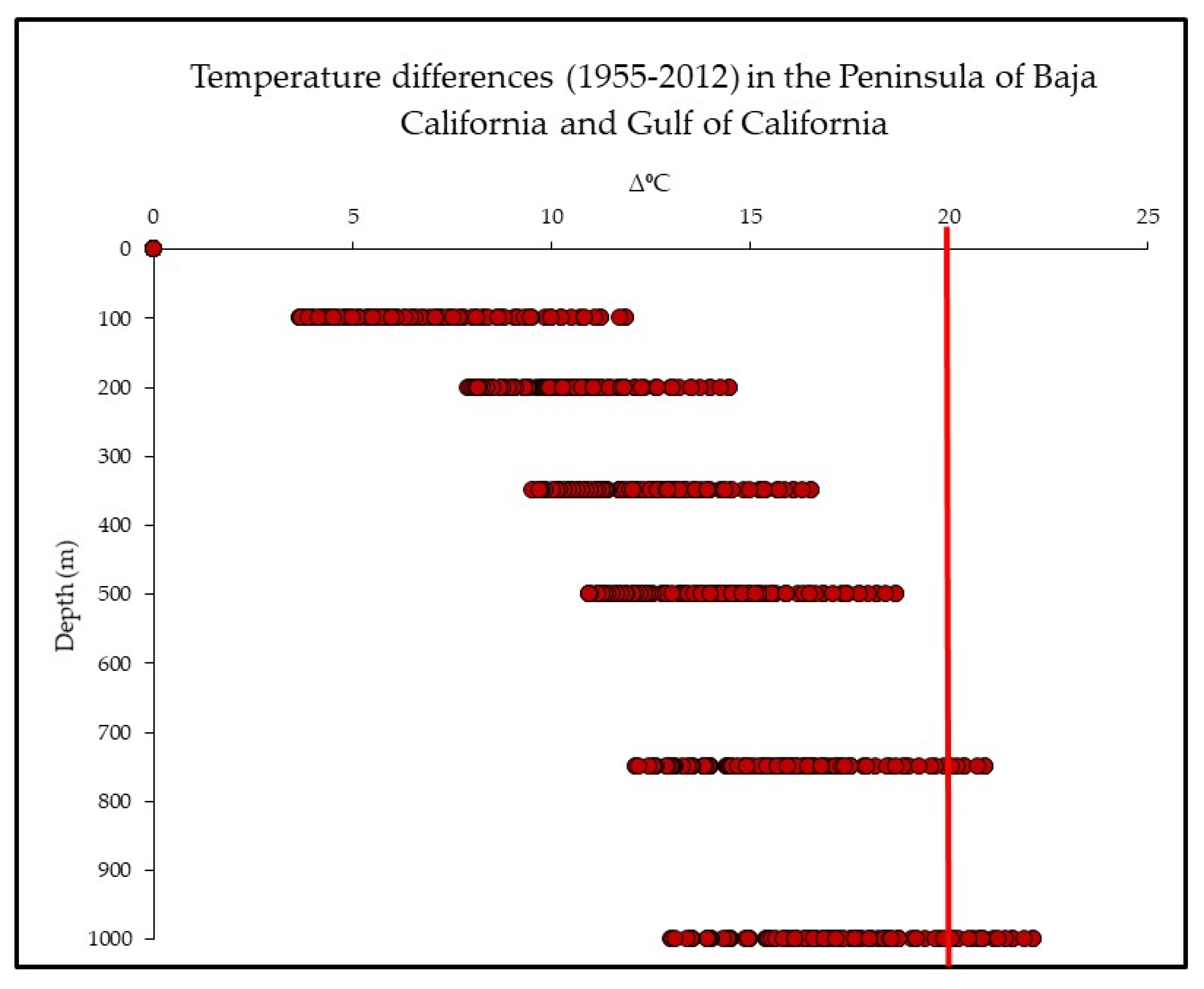
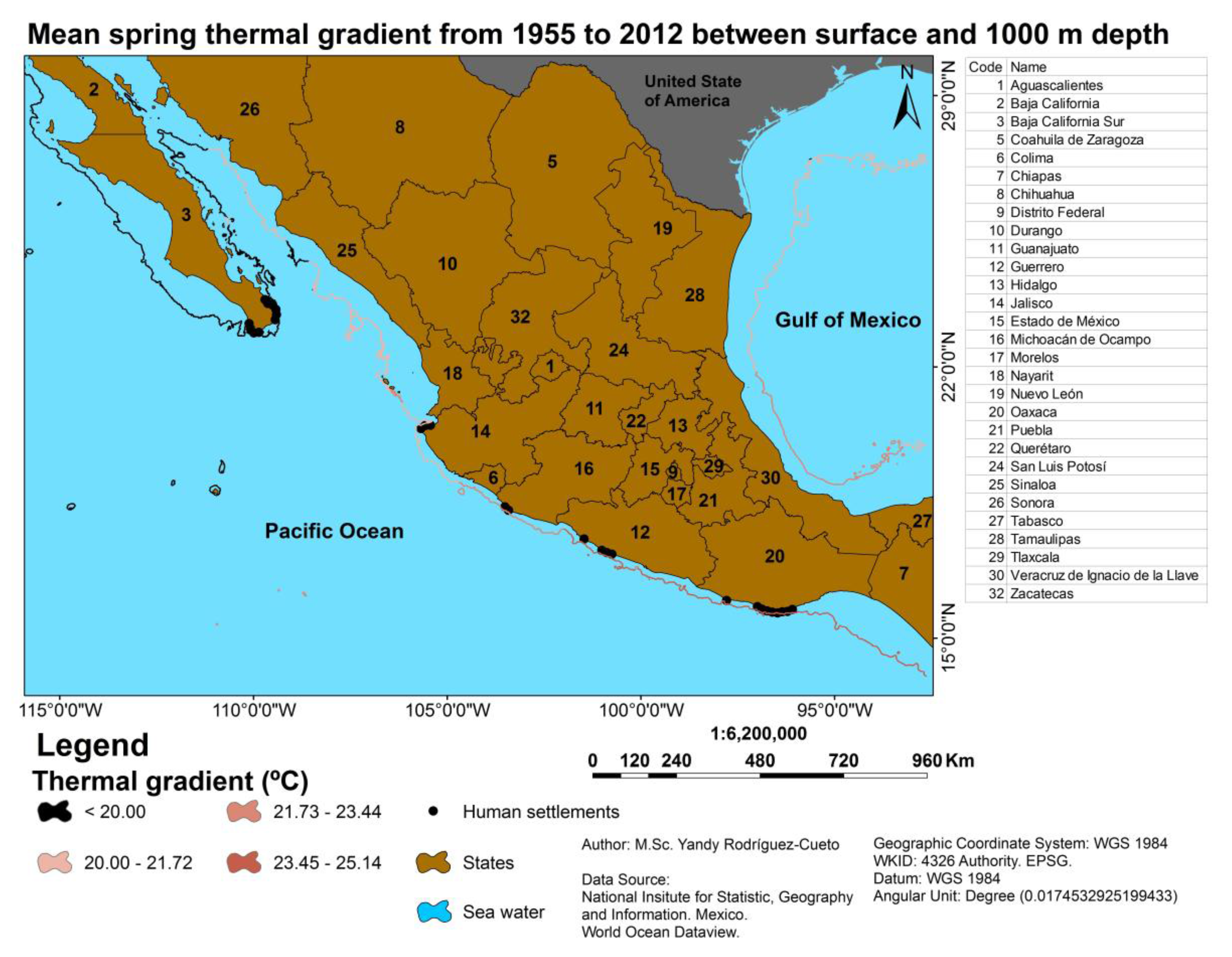
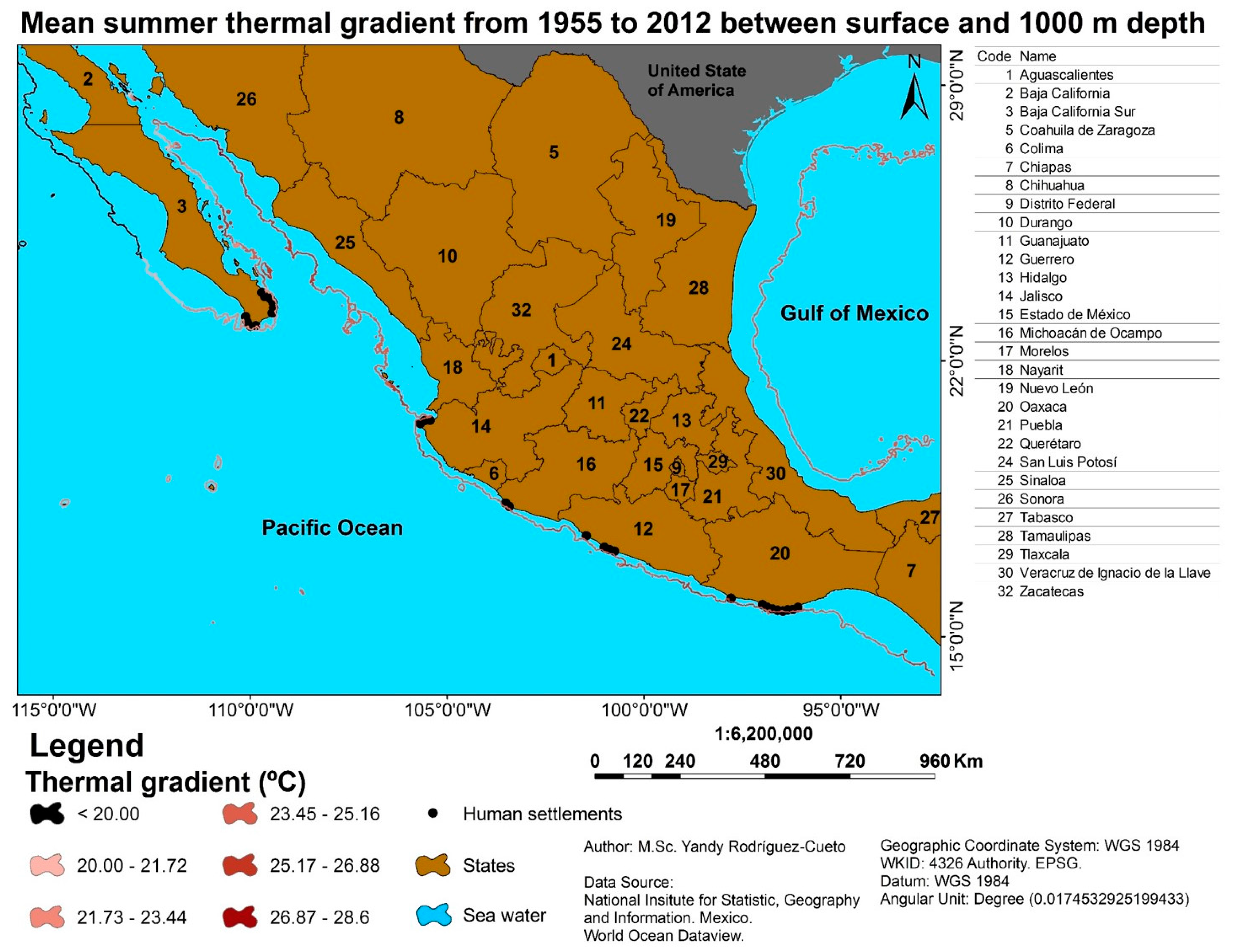
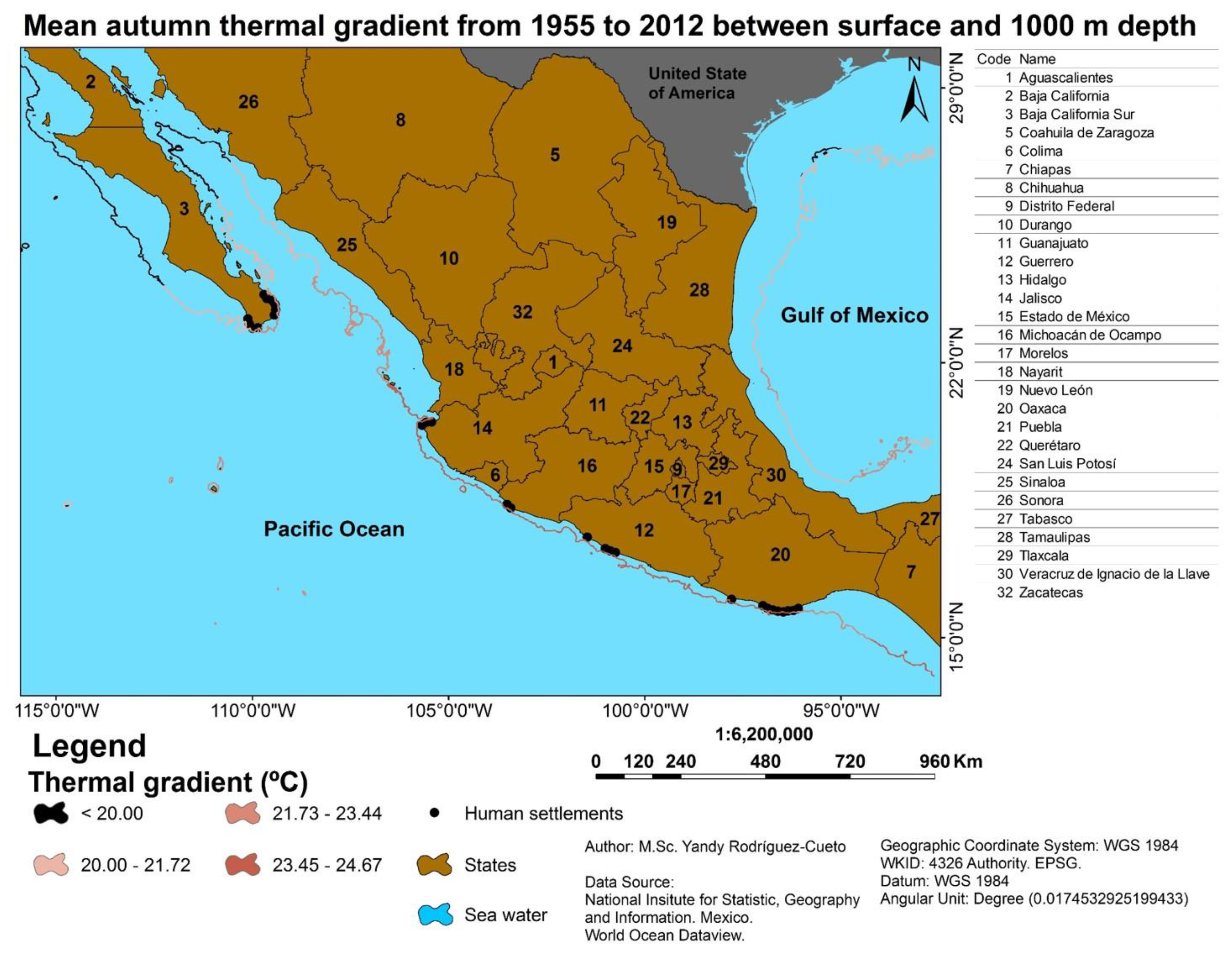
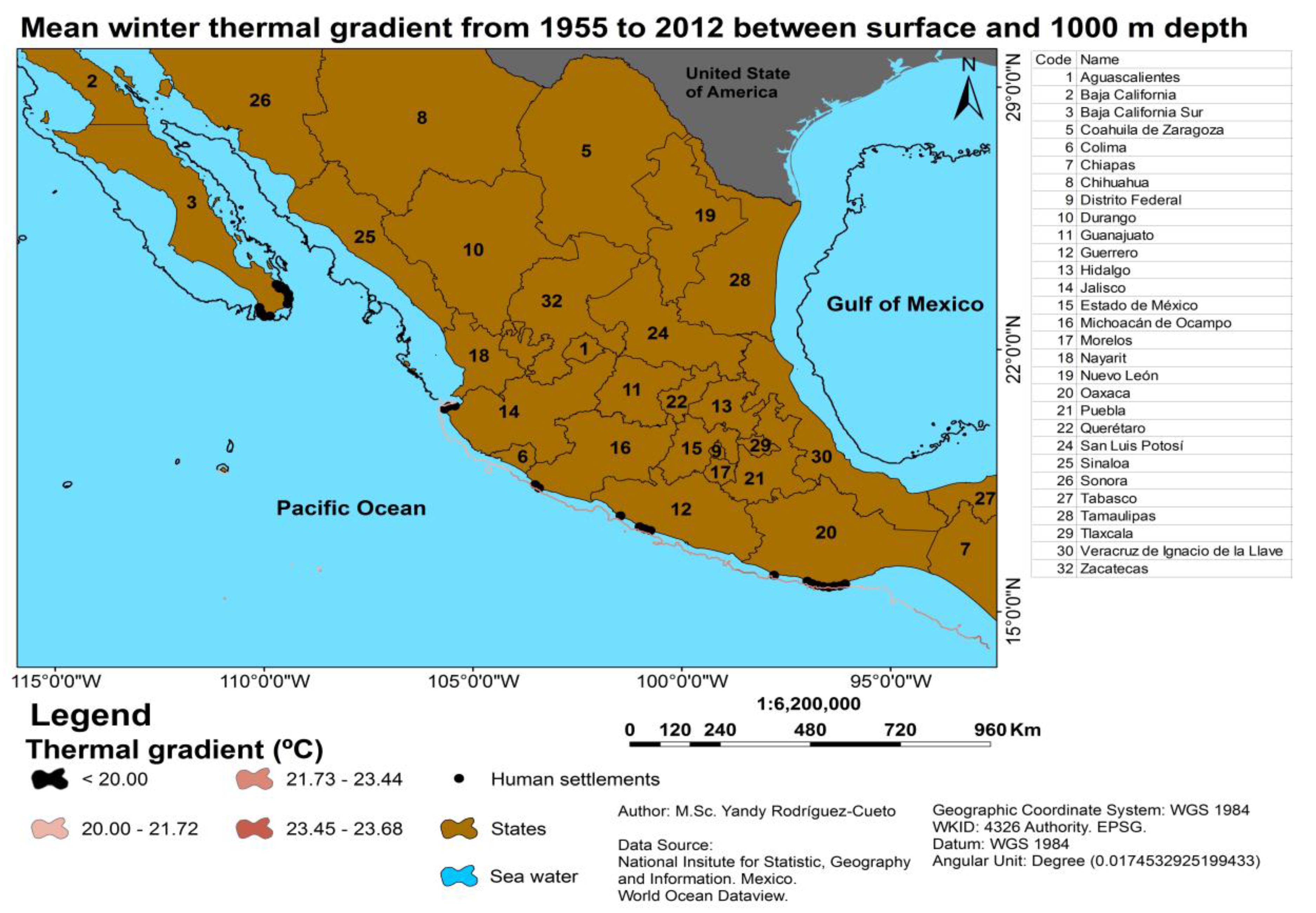
| Settlement | Distance in km |
|---|---|
| Tangolunda, Oaxaca | 10.2 |
| San Agustín Huatulco, Oaxaca | 4.5 |
| Puerto Ángel, Oaxaca | 7.5 |
| El Coyote, Oaxaca | 6.3 |
| Agua Blanca, Oaxaca | 9.3 |
| Los Naranjos, Oaxaca | 8.7 |
| El Azufre, Oaxaca | 6.9 |
| Nuxco, Guerrero | 9.4 |
| San Luis de la Loma, Guerrero | 9.6 |
| El Cobano, Guerrero | 9.6 |
| Barra de Potosí, Guerrero | 10.9 |
| Colola, Michoacán | 5.5 |
| Ostula, Michoacán | 9.9 |
| Cabo Corrientes, Jalisco | 8.9 |
| Yelapa, Jalisco | 5.5 |
| Los Frailes, BCS | 2.3 |
| Cabo San Lucas, BCS | 6.1 |
| Cabo Pulmo, BCS | 6.9 |
© 2018 by the authors. Licensee MDPI, Basel, Switzerland. This article is an open access article distributed under the terms and conditions of the Creative Commons Attribution (CC BY) license (http://creativecommons.org/licenses/by/4.0/).
Share and Cite
García Huante, A.; Rodríguez Cueto, Y.; Silva, R.; Mendoza, E.; Vega, L.A. Determination of the Potential Thermal Gradient for the Mexican Pacific Ocean. J. Mar. Sci. Eng. 2018, 6, 20. https://doi.org/10.3390/jmse6010020
García Huante A, Rodríguez Cueto Y, Silva R, Mendoza E, Vega LA. Determination of the Potential Thermal Gradient for the Mexican Pacific Ocean. Journal of Marine Science and Engineering. 2018; 6(1):20. https://doi.org/10.3390/jmse6010020
Chicago/Turabian StyleGarcía Huante, Alejandro, Yandy Rodríguez Cueto, Rodolfo Silva, Edgar Mendoza, and Luis A. Vega. 2018. "Determination of the Potential Thermal Gradient for the Mexican Pacific Ocean" Journal of Marine Science and Engineering 6, no. 1: 20. https://doi.org/10.3390/jmse6010020





